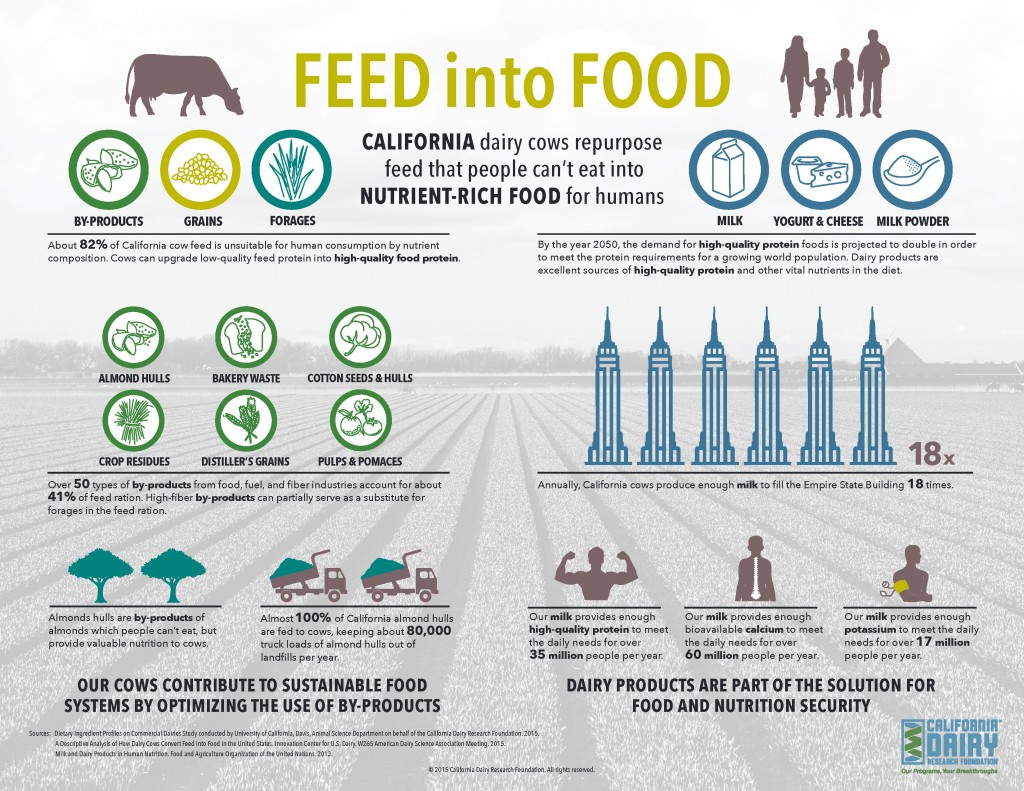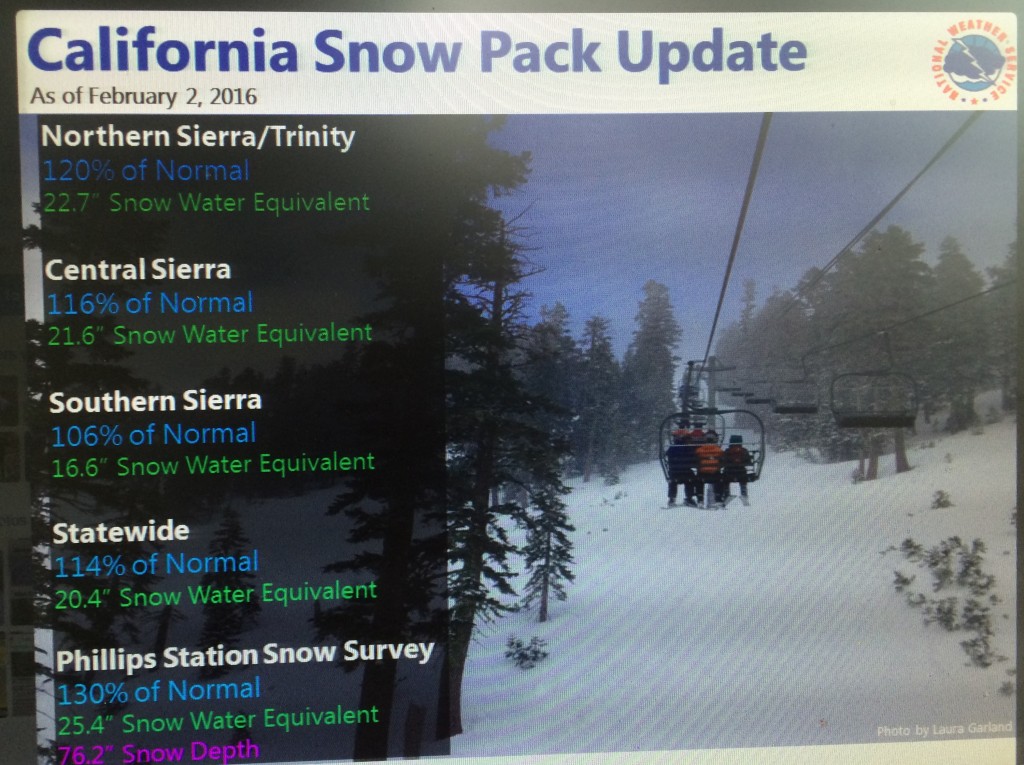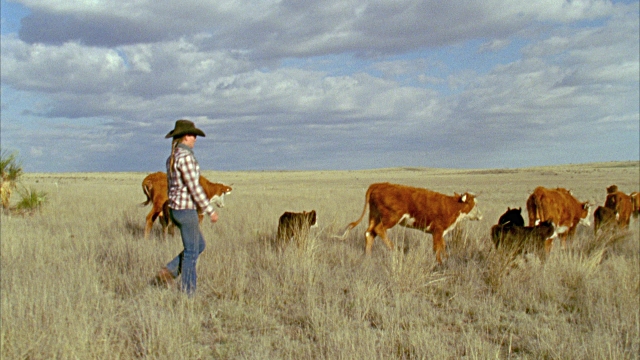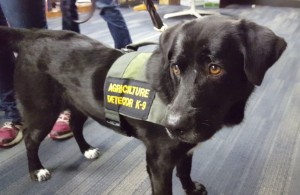-
Recent Posts
- Farm-to-School Month Grantee Spotlight: Santa Ana Unified
- Hispanic Heritage Month — Javier Zamora’s Journey from Farmworker to Farm Owner
- CDFA Celebrates National Farm to School Month!
- Celebrating Hispanic Heritage Month: CDFA Panel Discussion Reflects on Language, Identity and Community
- Secretary Ross at UN FAO Global Livestock Conference in Rome
Recent Comments
- Kathy de Contreras on CDFA IT department honored at “Best of California” awards
- El costo económico de las deportaciones masivas ya es visible en California - Espanol News on Nine California Counties Make Top-10 List for Ag Sales in the U.S.
- Deportations are taking a toll on California’s economy – and have only just begun – The News Beyond Detroit on Nine California Counties Make Top-10 List for Ag Sales in the U.S.
- Kenneth Cooper McNany on California Agricultural Heritage Club seeks nominations to honor pioneering farms and ranches more than 100 years old
- William Griffin on Lowering the boom on illegal fireworks — CDFA teamed up with San Bernardino County Fire to confiscate 13 tons prior to July 4th
Archives
- October 2025
- September 2025
- August 2025
- July 2025
- June 2025
- May 2025
- April 2025
- March 2025
- February 2025
- January 2025
- December 2024
- November 2024
- October 2024
- September 2024
- August 2024
- July 2024
- June 2024
- May 2024
- April 2024
- March 2024
- February 2024
- January 2024
- December 2023
- November 2023
- October 2023
- September 2023
- August 2023
- July 2023
- June 2023
- May 2023
- April 2023
- March 2023
- February 2023
- January 2023
- December 2022
- November 2022
- October 2022
- September 2022
- August 2022
- July 2022
- June 2022
- May 2022
- April 2022
- March 2022
- February 2022
- January 2022
- December 2021
- November 2021
- October 2021
- September 2021
- August 2021
- July 2021
- June 2021
- May 2021
- April 2021
- March 2021
- February 2021
- January 2021
- December 2020
- November 2020
- October 2020
- September 2020
- August 2020
- July 2020
- June 2020
- May 2020
- April 2020
- March 2020
- February 2020
- January 2020
- December 2019
- November 2019
- October 2019
- September 2019
- August 2019
- July 2019
- June 2019
- May 2019
- April 2019
- March 2019
- February 2019
- January 2019
- December 2018
- November 2018
- October 2018
- September 2018
- August 2018
- July 2018
- June 2018
- May 2018
- April 2018
- March 2018
- February 2018
- January 2018
- December 2017
- November 2017
- October 2017
- September 2017
- August 2017
- July 2017
- June 2017
- May 2017
- April 2017
- March 2017
- February 2017
- January 2017
- December 2016
- November 2016
- October 2016
- September 2016
- August 2016
- July 2016
- June 2016
- May 2016
- April 2016
- March 2016
- February 2016
- January 2016
- December 2015
- November 2015
- October 2015
- September 2015
- August 2015
- July 2015
- June 2015
- May 2015
- April 2015
- March 2015
- February 2015
- January 2015
- December 2014
- November 2014
- October 2014
- September 2014
- August 2014
- July 2014
- June 2014
- May 2014
- April 2014
- March 2014
- February 2014
- January 2014
- December 2013
- November 2013
- October 2013
- September 2013
- August 2013
- July 2013
- June 2013
- May 2013
- April 2013
- March 2013
- February 2013
- January 2013
- December 2012
- November 2012
- October 2012
- September 2012
- August 2012
- July 2012
- June 2012
- May 2012
- April 2012
- March 2012
- February 2012
- January 2012
- December 2011
- November 2011
- October 2011
- September 2011
- August 2011
- July 2011
- June 2011
Categories
- AG Vision
- Agricultural Education
- Agricultural Marketing
- Alternative Fuels
- Animal health
- Animal Welfare
- Asian Citrus Psyllid
- Biodiversity
- Border stations
- BSE
- Cannabis
- Cannella Panel
- Climate Change
- Climate Smart Agriculture
- Community-based Food System
- Conservation
- Dairy
- Drought
- Environment
- Fairs
- Farm Bill
- Farm Labor
- Farmers' Markets
- Fertilizer
- Food Access
- Food Safety
- Food Waste
- Glassy-winged Sharpshooter
- Growing California
- Healthy soils
- HLB
- Hydrogen
- Integrated Pest Management (IPM)
- Invasive Species
- Light Brown Apple Moth
- Livestock ID
- Measurement Standards
- Nutrition
- Organic agriculture
- Pierce's Disease
- Pollinators
- Specialty Crops
- State Board of Food and Agriculture
- Succession Planning
- Trade
- Uncategorized
Pages
RSS

New central kitchen for Oakland schools to provide fresh, locally sourced meals – from insidebayarea.com
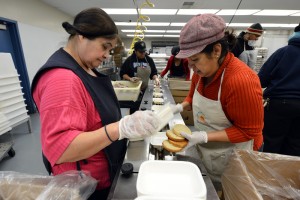
Hilda Yanez, left, and Carmen Cerrato assemble hamburgers for school lunches in Oakland. (Kristopher Skinner/Bay Area News Group)
(NOTE – a related video follows this story)
By Joyce Tsai
Fourth-grader Kali Jefferson sat in the Prescott Elementary School lunchroom surrounded by a coterie of friends, the only one among them who hadn’t brown-bagged it that day.
“It smells better today,” she said, wrinkling her nose, as she poked her fork into a school cafeteria-prepared Styrofoam tray of barbecue chicken and brown rice, accompanied by a small side salad — both shrink-wrapped with plastic. She only ate half her meal, while her friends wolfed down their home-prepared lunches.
“Children are picky,” said her mom, Nailah Watkins. “A lot of times, she’ll eat an orange at lunchtime, and trash the rest. I’ll go into the lunchroom and see food half-eaten and (in the garbage). There’s so much food wasted.”
But change is coming.
An ambitious plan by the Oakland Unified School District to build a $40 million central kitchen, instructional farm and education center at the corner of 29th and West streets in West Oakland will transform how school meals are made throughout Oakland.
The state-of-the-art kitchen is the district’s attempt to invest more in the growing farm-to-school movement. A central hub will feed a constellation of local finishing kitchens at every district school site that will cook a steady stream of fresh, healthy, locally sourced meals every day.
One of the first of its kind in the nation, the 48,000 square-foot center will provide learning opportunities in the culinary arts and agricultural instruction, and help urban school kids learn where their fruits and vegetables come from and how food is prepared. Construction starts this winter, and the center should be up and running by the 2017-2018 school year.
“The project will help us radically change the food that we serve in the district, because right now, we can only serve individually prepackaged foods,” said Jennifer LeBarre, OUSD’s executive director of nutrition services.
The entire school district is served by two central kitchens, one at Oakland High and another at Prescott Elementary. Together, those facilities prepare more than 30,000 meals a day — more than 7 million meals a year. Both are too small and outdated to act as a central location for fresh, locally sourced food to be delivered and prepared daily. The prepackaged meals they produce are often heated up at individual school sites with microwave ovens.
The concept for the Central Kitchen came about after the district partnered with the Berkeley-based Center for Ecoliteracy and the TomKat Charitable Trust. The groups were looking to partner with a school district to launch a plan that would address how caring for children’s nutritional and physical well-being would help them better succeed in the classroom and in life, said Zenobia Barlow, the Center for Ecoliteracy’s executive director.
“Oakland is a place where there is really significant hunger,” she said. About 73 percent of the district’s students are eligible for free and reduced meals. And research also shows that when students have access to healthy meals — real, not processed food — those students perform at higher levels.
The project is not without its detractors. Some residents think the center doesn’t belong in a residential neighborhood. It is being constructed on the site of the former Marcus Foster Middle School, which was designed by Robert Kennard, a prominent African-American architect who won an award with his colleagues for its open space design in the 1970s.
The middle school closed some time back, but the campus until recently housed special education programs and community basketball courts. Demolition of the school, ironically, started on Martin Luther King Day, further upsetting its opponents.
Plans to build on the site have been in the works since 2011, even though the community was only notified early last year about the project, said Lynne Horiuchi. She pointed out that the Foster-Hoover neighborhood has a history of having its wishes ignored.
“The imposition of the Central Kitchen development on this historically black community is an environmental injustice,” she said.
“Something like this would never happen above (Interstate) 580 in Temescal or Rockridge,” said resident Madeline Wells. “It will change the community forever.”
School trustee Jumoke Hinton-Hodge acknowledges the community engagement on the project could have been better, but she said the project is about social justice for students districtwide.
In Oakland, “families are working class, working poor and living below the poverty line,” she said. “And we know these kids don’t learn because they are malnourished … so I feel really good about the value this project will bring to the overall community.”
———————————-
In 2013 CDFA produced a video as part of its “Growing California” series showing the benefits of a central kitchen approach in the Riverside Unified School District.
Posted in Uncategorized
1 Comment
California snowpack update from the National Weather Service
Posted in Uncategorized
Leave a comment
UC Davis experts evaluate water year, so far
From the UC Davis Center for Watershed Sciences
January 2016 (was) much wetter than the previous Januaries during this drought. Precipitation is modestly above average, as is snowpack, and climatic conditions remain promising. The largest reservoirs are mostly fuller than a year ago, although not nearly to average conditions for this time of year. Groundwater is likely to be recharging, as it should this time of year in most places, but we still sit atop a large hole.
California remains in a drought. Precipitation and snowpack are now mostly above average for this time of the water year (the 2016 Water Year began October 1, 2015). So far, El Nino is delivering a somewhat above normal water year. But, overall 2016 drought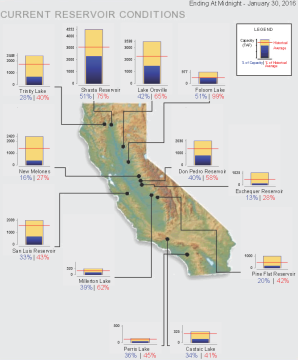 conditions are likely to remain unclear until March.
conditions are likely to remain unclear until March.
The California Department of Water Resources’ California Data Exchange Center (CDEC) does a great job assembling data that give insights on water conditions. They update this every day at http://cdec.water.ca.gov.
Here are some recent highlights, with links.
Reservoir and Groundwater Storage Conditions
Most major reservoirs in California have more storage that at this time last year, but still have only about 60% of historical average for this time of year. Folsom Lake is now at 100% of average for this time of year, rising from a record-low level in November. But California’s reservoir storage remains about 7 maf (about 7 full Folsom reservoirs) less than average for this time of year.
Groundwater statewide is harder to assess, but is doubtless making some recovery from last year’s levels. It still has a long way to recover from the drought in many places.
The drought so far has depleted total storage in California by about 22 maf cumulatively or nearly a year’s worth of water use in agriculture. Soil moisture conditions were also unusually dry following 2015, diverting and delaying some runoff from early storms.
- http://cdec.water.ca.gov/cgi-progs/products/rescond.pdf
- http://cdec.water.ca.gov/cgi-progs/reservoirs/RES
Precipitation and Snowpack

December and January storms have helped, with precipitation and snowpack mostly a bit above average for this time of year. We seem to have overcome the Curse of Zero Januaries; January precipitations for the last three years was nearly zero. This January precipitation in the Northern Sierras is above average and exceeds the sum of all January precipitation for the last five years!
Snowpack in California is mostly above average for this time of year and already greatly exceeds last year’s snow accumulations. There is a ski season.
Is it El Nino yet? Apparently, yes. But it is giving us slightly better than average conditions, which so far are much better than the last four years. No major floods yet. So far, the forecast for February looks good.
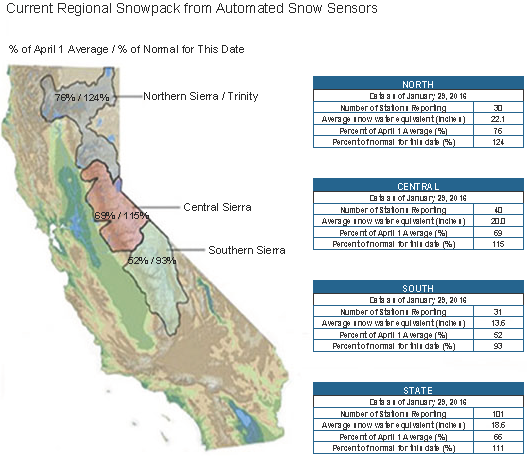
Snowpack:
- http://cdec.water.ca.gov/cdecapp/snowapp/sweq.action
- http://cdec.water.ca.gov/cgi-progs/snow/PLOT_SWC
- http://cdec.water.ca.gov/cgi-progs/products/swccond.pdf
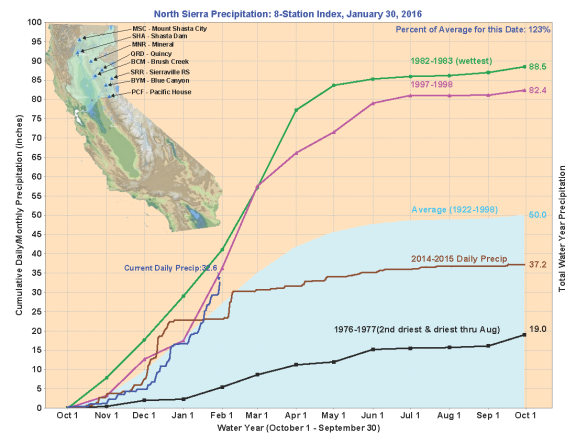
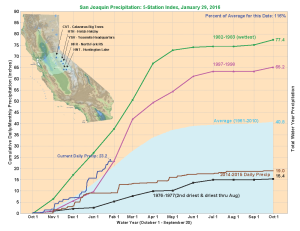
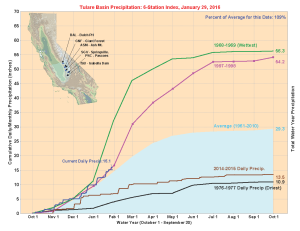
Precipitation:
- http://cdec.water.ca.gov/cgi-progs/products/PLOT_ESI.pdf – Sacramento Valley
- http://cdec.water.ca.gov/cgi-progs/products/PLOT_FSI.pdf – San Joaquin Valley
- http://cdec.water.ca.gov/cgi-progs/products/PLOT_TSI.pdf – Tulare Basin
Concluding thought
Steady, above average precipitation and a decent snowpack, so far. Much better than the last four years. Let’s hope it continues, but remain prepared for another drought year, or at least lingering drought effects even if conditions are modestly wet this year.
Wonks might be interested in UC Davis’ ongoing seminar series on drought impacts and policy (most Mondays at 4pm on the UC Davis campus). The public is welcome and videos are posted some days after each talk. Details at:https://watershed.ucdavis.edu/education/classes/california-water-policy-seminar-series-drought This Monday we’ll hear from Peter Moyle (UC Davis) and Jay Ziegler (TNC) on ecosystem impacts and management during the current drought.
Posted in Uncategorized
Leave a comment
Women expand their home on the range – from the Washington Post
By Elizabeth Zach
Although Laura Jean Schneider comes from four generations of Midwest farmers, she is uncertain sometimes about her agricultural acumen.
For the past two years, she has ranched cattle across 100,000 acres on the Mescalero Apache Reservation in southern New Mexico with her husband. It is, she says, dangerous work compared with the farming she once did in Minnesota with her family. For one thing, should either she or her husband need immediate medical care, it would be a hard ride over 27 miles of uneven dirt roads that flood during monsoon season.
And at age 31, she suffers from debilitating migraines, back pain and ongoing dental work following a near-fatal car accident a decade ago. There are bank loans, and the West’s ongoing drought, that weigh on her. Yet she’s learned the ropes, as it were, keenly observing how cattle learn the landscape they live in, and how not all of them are naturally good at rearing their young.
“I rope, ride and build fence,” she says matter-of-factly. “This is what I do. It’s my job.”
As unique as Schneider seems, she is far from alone. According to the U.S. Agriculture Department, the number of women-operated farms increased from 5 percent to 14 percent between 1978 and 2007. Today, counting principal operators and secondary operators, women account for 30 percent of all farmers in the United States, or just under 1 million.
As striking as those numbers are, particularly when considering the financial risks and physical demands that accompany the work , researchers say they would like to learn more about the full contribution these women make, and what it means for the future of farming and ranching in the United States.
Researchers have observed some possible reasons why more women are farming and ranching. Some women regard themselves less as entrepreneurs and more as gentle stewards of the land, or bulwarks against corporations overtaking family farms and developers sweeping in with seductive offers. Others are drawn to the farm-to-fork movement, where locally grown produce and meat hold much greater appeal. Also, more women are inheriting farms and ranches.
Downsizing and mechanization have also made the work more affordable and less physically demanding — although “smaller parcels tend to require more physical labor because they are typically managed using hand tools and practices,” said Breanne Wroughton, program assistant for the California Farm Academy at the Center for Land-Based Learning in Winters, Calif.
To that end, Green Heron Tools in New Tripoli, Pa., is part of a burgeoning niche industry that customizes farm equipment for women, including a tractor rapid hitch, because the traditional tool for attaching and detaching parts “is at best difficult and at worst impossible for women (and many men) to safely manage on their own,” according to the company’s website.
None of this much matters, however, to Megan Brown, as she leans over her squealing Red Wattle pigs with a fork in her hand so that she can poke and stroke their backs, which, she claims, soothes them and stimulates their appetites. Born and raised on her parents’ sprawling ranch at the base of Table Mountain near Oroville in northern California, Brown, 34, has made a name for herself raising her heritage pigs and selling their savory meat to local residents and gourmet San Francisco restaurants.
With a swashbuckling demeanor that has attracted a loyal following to her Twitter account (@MegRaeB) and made her a regular fixture at agriculture conferences, she emphatically calls for more women to, so to speak, enter the field.
“My mother taught me to develop as many marketable skills as possible, so it’s not just the ranching with me,” said Brown, as she swerved her Polaris ATV across the rocky plateau skirting her parents’ ranch. “I cure olives, make beef jerky. I’ve planted tobacco, I can skin my own deer. I got a tractor, and I can lift heavy things with it myself. . . . I really believe any woman can do what I’m doing.”
According to the USDA, the women who identified themselves as earning their primary income from farming or ranching run the gamut in terms of what they produce. They raise cattle, sheep, poultry, pigs and goats in the West and Midwest. They are viticulturists — or, as they refer to themselves at times, “vit-chicks” — who nurture malbec and pinot noir grapes in California, Washington and Oregon. They grow lavender, melons and seemingly every other delicacy under the sun.Some have taken on teaching roles and find that more and more women are joining their ranks.
“[Women’s] enrollment in the classes has been fairly consistent throughout the last four years of the program,” said Wroughton, “and 51 percent of our graduates have been women.”’
And then there are women like Donna Schroeder, who at 77 was never schooled in ranching but was clearly born to the land and still ranches it in Shonkin, Mont.
She says she has no plans to retire, despite admitting to a small profit margin along with plenty of bank debt and machinery upkeep. “If someone wants to do ranching these days,” she said, “basically someone has to get out so you can get in. There’s only so much to go around.”
One of the few women to be inducted into the National Cowboy Hall of Fame, Schroeder is wizened and walks with a slight limp. Her husband died more than 30 years ago; neither of her two children live nearby nor plan to take over the ranch when she no longer can run it.
Cheryl Cosner, 52, who runs a sheep and cattle ranch with her husband in northeastern Oregon, speculates that one of her two daughters could eventually take the reins. She studied agriculture economics and animal science at a time when, she estimates, about only 30 percent of her fellow students were female. She later taught business administration in China and took art classes that proved helpful when she started marketing her farm products.
Last year, Brenda Kirsch Frketich prepared to take over her family’s Oregon farm. When her father retired, he appointed her to carry the torch at this 1,000-acre Willamette Valley farm that’s been in the family for four generations.
She’d proven her mettle: When she was pregnant with her first child, she was out in the fields — long days, long nights, she recalled, when she had to swath and cut the grass into rows so that the dew would hold the seed on the straw stems for when the combine came through. She is now 32 and has a business degree. In taking over the farm, she oversees three employees, seasonal workers and the planting and harvesting of perennial rye and tall fescu grass, wheat, crimson clover, hazelnuts, green beans, Swiss chard, peas, cabbage and radishes.
“When I started with all this, I was 11 years old,” she said. “My feet couldn’t reach the tractor pedals.”
While moving some records and files into her new makeshift office, she came across a weathered leather-bound ledger book, with orderly figures and notes marching across the pages. She marveled at the detailed, pristine penmanship, now fully aware of her grandmother’s essential role in the family’s business and legacy.
“You can learn the dirt, learn the soil, you can learn the tools,” Frketich said, “but you also need to understand the business. She did.”
Elizabeth Zach is a fellow at Stanford University’s Bill Lane Center for the American West
Posted in Uncategorized
Leave a comment
World Economic Forum commits to reducing food waste
At the World Economic Forum in Davos last week, a coalition of 30 leaders – Champions 12.3 – launched a new effort to inspire ambition and mobilize action to reduce food loss and waste globally. This leadership group aims to accelerate progress toward meeting Target 12.3 of the UN Sustainable Development Goals (SDGs), which seeks to halve per capita food waste and reduce food losses by 2030.
Globally, a third of all food is lost or wasted between the farm and the fork. Reducing food loss and waste can be a triple win: It can save money for farmers, companies, and households; wasting less can feed more people; and reductions can alleviate pressure on climate, water, and land resources.
The Champions include CEOs of major companies, government ministers, and executives of research and intergovernmental institutions, foundations, farmer organizations, and civil society groups. These leaders will work to create political, business and social momentum to reduce food loss and waste around the world.
The Champions will inspire action by:
- Leading by example on how to reduce food loss and waste;
- Motivating others to meet SDG Target 12.3;
- Communicating the importance of food loss and waste reduction;
- Showcasing successful food loss and waste reduction strategies; and
- Advocating for more innovation, greater investment, better information, and increased capacity to reduce food loss and waste.
Food loss and waste has significant economic, social, and environmental consequences. According to the Food and Agriculture Organization of the United Nations (FAO), food loss and waste amounts to $940 billion in global annual economic losses. It contributes to hunger. And lost and wasted food consumes about one quarter of all water used by agriculture, requires cropland area the size of China, and generates about 8 percent of global greenhouse gas emissions.
Champions 12.3 will complement and build upon ongoing successful UN programs to reduce food loss and waste including SAVE FOOD and Think.Eat.Save, efforts such as EU FUSIONS and the global Food Loss & Waste Protocol, private sector action like the Consumer Goods Forum’s Food Waste Resolution, and other initiatives.
The Champions effort supports the UN Sustainable Development Goals adopted in September 2015. SDG 12 seeks to ensure sustainable consumption and production patterns. Target 12.3 specifically aims to halve per capita global food waste at the retail and consumer level, and reduce food losses along production and supply chains, including post-harvest losses, by 2030.
Inspired by the “No More Food to Waste” conference in The Hague in June of 2015, the Government of the Kingdom of the Netherlands formally called for the coalition’s formation in September 2015, and is providing secretariat support for Champions 12.3, along with World Resources Institute.
See the full list of champions and get more information at:http://champions123.org.
Posted in Uncategorized
Leave a comment
California Agricultural Mediation Program a new resource to help farmers resolve problems
Farmers and ranchers are a self-reliant group. They can tune and service tractor engines, repair irrigation systems, and find a way to fix all kinds of broken farm equipment. But there are other kinds of problems they face where they can use some outside assistance – issues with loans, creditors, and USDA agencies. The California Agricultural Mediation Program (CALAMP) is a new service that provides free mediation to the agricultural community in California on a variety of issues.
Mediation is a way to resolve all kinds of problems by utilizing a neutral person to keep the dialogue constructive, overcome challenges in communication, help the parties develop options, evaluate those options, and reach an agreement. Unlike arbitration or the court system, mediation is voluntary. The mediator doesn’t make an order or impose a solution on the parties. If you don’t like any of the options discussed at mediation, you can simply walk away and be in the same situation as you were prior to the mediation.
CALAMP is certified by CDFA and the USDA as the official agricultural mediation program for California. The most common issues where CALAMP can help involve adverse decision letters or other compliance issues with USDA agencies such as NRCS, farm loans regardless whether the lender is FSA, a Farm Credit System bank, or a private lender, and credit issues.
CALAMP’s director Matt Strassberg anticipates that in particular they will be able to help many small and medium sized farms with credit issues. According to Matt Strassberg, “farms that are behind on accounts are often charged interest and after awhile that interest really adds up. CALAMP can help the parties reach an installment payment plan that is affordable and acceptable to the creditor. Even though the creditors often make some compromises, they are usually willing to enter into settlement agreements because they know they will be paid.”
For more information about CALAMP, their website is www.calamp.org, or (916) 330-4500 ext 101 or info@emcenter.org.
Posted in Uncategorized
Leave a comment
Ag statistics for 2014 show trends for farm sales, exports
In 2014, the most recent year for which a full crop-year report is available, California’s 76,400 farms and ranches received approximately $54 billion for their output. This represents an increase of 5.1 percent over 2013. California is the leading US state in cash farm receipts with combined commodities representing nearly 13 percent of the US total.
California’s agricultural abundance includes more than 400 commodities. Over a third of the country’s vegetables and two-thirds of the country’s fruits and nuts are grown in California. The dairy industry, California’s leading commodity in cash receipts, generated a record $9.36 billion for milk production in 2014, up 23 percent from 2013 and 22 percent above the record year of 2011.
California’s top-ten valued commodities for 2014 are:
Milk – $9.4 billion
Almonds – $5.9 billion
Grapes – $5.2 billion
Cattle and calves – $3.7 billion
Strawberries – $2.5 billion
Lettuce – $2 billion
Walnuts – $1.8 billion
Tomatoes – $1.6 billion
Pistachios – $1.6 billion
Hay – $1.3 billion
In 2014, California’s agricultural exports amounted to $21.59 billion in value. As a percentage of the total US agricultural exports for 2014, California’s share represents 14.3 percent—slightly less than the 14.9 percent share reported the previous year. California’s top 10 export destinations—European Union, Canada, China/Hong Kong, Japan, Mexico, Korea, India, United Arab Emirates, Turkey, and Vietnam—accounted for 69 percent of the 2014 export value. For 2014, India showed the largest growth in total export value compared to the previous year at 19.1 percent.
California agricultural statistics derive primarily from the United States Department of Agriculture/National Agricultural Statistics Services (USDA/NASS) reports. The California Department of Food and Agriculture also publishes statistics related to California dairy production and, in cooperation with the University of California at Davis, statistics for California agricultural exports.
For most timely research into California dairy statistics, please see our dairy pages under Division of Marketing Services. Please see also links in the right hand column for USDA National Agricultural Statistics and Economic Research Service reporting. For county-level reporting please see the CDFA County Liaison site.
Dogs enlisted to help protect citrus – from California Ag Today
By Charmayne Hefley
Animals have been known to be able to use their senses to detect things that humans require extensive technology to detect. Mary Palm, USDA Animal and Plant Health Inspection Service (APHIS) national coordinator for citrus pest programs, said dogs have been successfully trained to detect canker disease, and now Huanglongbing disease (HLB), in citrus.
“Over the past four to five years,” Palm said, “a researcher in Florida first determined dogs could actually detect canker, began training dogs,” Palm said, “and then trained different sets of dogs to detect it. It turned out that they were very good at it. In a demonstration there, none of the people could find any symptoms in a particular citrus tree, but the dogs came through and found the symptoms. Once the people came back and looked very closely, sure enough, it was there.”
Palm said the USDA Huanglongbing Multi Agency Coordination (MAC) Group funded research to determine if dogs could detect HLB in citrus as well as they detected canker. There are now five dogs being trained and tested daily. If grower demand increases, the use of canines in pest management could increase.
Palm said they will probably come up in the next year or two with certification criteria for other companies to train dogs and certify them as detectors. Palm said, “They would be able to get a certificate to show they had conducted all of the tests necessary with the [proper] degree of accuracy.” Palm said the dogs in this program have a 99 percent success rate at detecting HLB disease.
Palm said approximately 80 trees are put inside every night, the positive ones in one greenhouse and the negative ones in another. The trees are taken out the next day and positioned in different patterns for dogs to inspect throughout the day. When the dogs are brought out, even their trainers don’t know which trees are positive or negative. The trained dogs are more than 99 percent accurate.”
Posted in Uncategorized
1 Comment
Ag seeks Silicon Valley’s help to satisfy world food demand – from thinkprogress.org
By Natasha Geiling
Though it’s just an hour south of California’s Silicon Valley, the Salinas Valley — better known for churning out lettuce and tomatoes than the world’s newest tech devices — might as well be a world away. In Silicon Valley, companies like Apple, Hewlett-Packard, Intel, and Google reign supreme. In Salinas, the biggest names are those of fruit and vegetable producers — Dole Foods, Chiquita, Driscoll Berries, Taylor Farms.
But the distance between the two places could soon seem a little smaller, thanks in part to a new effort on the part of the agriculture industry to attract technology companies to the Salinas Valley. Last month, the Western Growers Association — a trade association representing local and regional produce growers from California, Arizona, and Colorado — opened the Center for Innovation and Technology in Salinas, CA. The space — which has room for 34 startups to work, take classes, and meet with farmers — hopes to serve as a midway point between the innovative ideas of tech companies and the technical know-how of industry experts.
“Demand for food is increasing dramatically across the world because of increased population,” Tom Nassif, CEO of the Western Growers Association, told ThinkProgress. “You also have diminishing natural and human resources, and you’ve got to increase your production by 70 percent in 40 years to feed the world’s population. How do you do that?”
The answer, according to Nassif, is through technology that helps farmers use as few resources as possible to produce the largest amount of food — from reducing the amount of water needed to grow certain crops to reducing the amount of wasted product left in the field.
Nassif and the Western Grower’s Association are far from the first to suggest that technological innovations could help propel agriculture into the future, nor is this the first time in history that agriculture and technology have entered into a close relationship. In the 1960s, scientists like Paul R. Ehrlich — Stanford professor and author of the best-selling Population Bomb — issued grave warnings of impending mass starvation due to population growth. Instead, thanks to a slew of technological innovations in crop breeding, the world was able to significantly increase the amount of yield per acre for key crops like maize, wheat, and rice. Dubbed the Green Revolution, technological advances helped double the yields of rice and wheat across Asia, sustaining a population that grew over the same period of time by 60 percent. Though not without controversy — especially with regard to the rapid adoption of chemicals in agriculture — over the course of a few decades, the Green Revolution succeeded in steering the world away from earlier predictions of global starvation.
But those predictions have begun to resurface in recent years, stirred by the potential for climate change to disrupt agricultural systems at a time when the world’s population continues to grow.According to the United Nations, the world will need to feed more than 9 billion people by 2050, meaning that food production will need to increase by 70 percent. That creates a huge potential for new technologies that can either boost agricultural production, efficiency, or both.
In the United States, federal funding for agriculture technology peaked in the years following the Dust Bowl and around World War II, when 40 percent of federal research and development expenditures went towards agricultural research. Today, with just 2 percent of federal research and development spending going towards agricultural research, private investment companies are looking to fill a void left by shifting governmental priorities.
“All indications are that this is the new industry for investment in high tech,” Nassif said. “We’ve only been open a month, and we already have a number of tenants, more coming in every day, and more people indicating a desire to sponsor the venture as well as invest in agricultural technology.”
Created as California looks to leave behind the historic drought that has plagued the state for the past four years, the Center for Innovation and Technology is especially interested in technology to help farmers maintain crop yields in the face of diminishing access to water.
“Obviously using less water and using less labor are our highest priorities,” Nassif said, citing technology like drones that can map where exactly on a field water is needed most, or technology that can help a crop retain more water in its roots, as examples of the kinds of innovation he hopes to see come from the center.
Jeffrey Orrey, president and CEO of GeoVisual Analytics — one of six start-ups working out of the Center right now — is already engaged in creating technology that would help farmers use drones, as well as smaller manned aircrafts, to create high resolution images of their fields — technology similar to work that he used to do for NASA. By giving farmers a way to better monitor how their crops are grown, Orrey says, farmers are able to use inputs — like water, or fertilizer — as efficiently as possible on their land.
“Over time, with resource shortages and increasingly severe changes in weather and climate, it’s going to become imperative that we are more quantitative and better at monitoring how crops are grown to better understand how to respond to these drastic changes,” Orrey told ThinkProgress.
Giving farmers better access to quantitative data in the field also has co-benefits for the environment — the more real-time information a farmer has about their field, the more precise they can be with their application of things like pesticide, fertilizer, and water. That could help reduce the amount of excess fertilizer that ends up degrading water quality as runoff, the amount of water used throughout an operation, or the amount of pesticide needed to treat a field.
Orrey was drawn to the Center, he said, because it allowed his company a chance to interact directly with farmers and industry — a piece of the puzzle that can be missing for some entrepreneurs hoping to create new technology for agriculture.
“Unless you come from a farming background, we saw that there was a disconnect between high tech companies that think they have solutions but really don’t appreciate the nuance of making them applicable to the farm,” he said. “[The Center creates] the opportunity to bring the tech together with people who are doing farming and know the complexity.”
Nassif said that the Center’s location — close to the farmers of the Salinas Valley and within driving distance of both Silicon Valley and San Francisco — makes it an ideal first location, but he hopes that more Innovation and Technology Centers will open throughout the state in the near future.
“I think we’ll outgrow the Center very quickly, and that’s a good thing,” he said. “I think that given the appropriate attention and investment, the Center has nowhere to go but up, and to attract more and more innovators through employment and high tech jobs in agriculture.”
Posted in Uncategorized
Leave a comment


